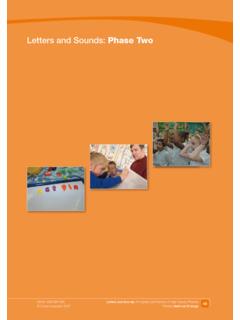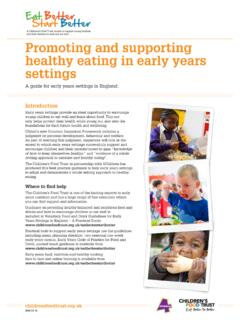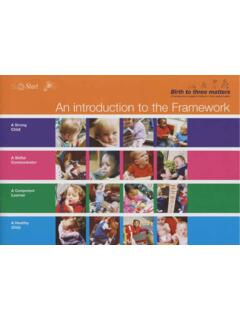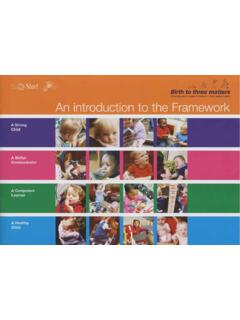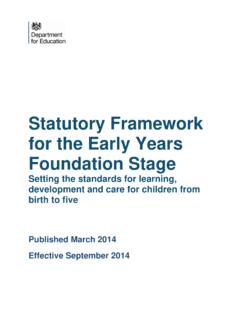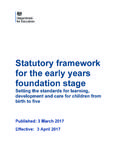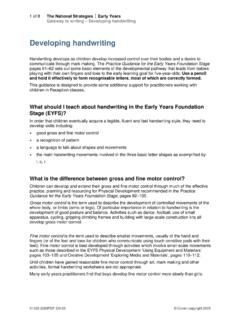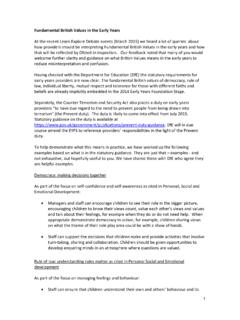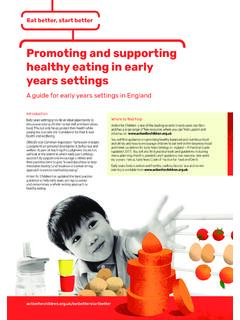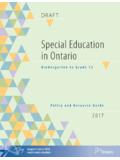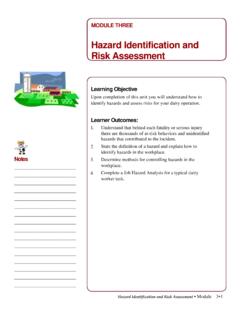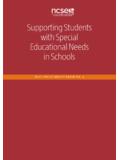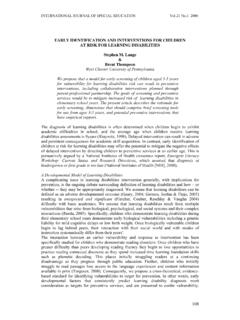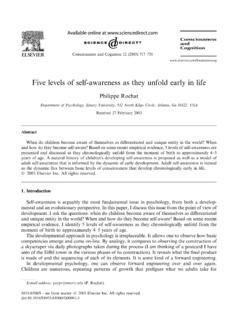Transcription of SEN and disability in the early years: A toolkit
1 SEN and disability in the early years : a toolkit Section 4 First concerns and early identification Page 1 of 5 Section 4: First concerns and early identification This section of the toolkit is about how settings should respond to initial concerns about a child s progress and how to identify special educational needs. This is important because an early response to a concern and early identification and intervention are key to helping children to reach their potential. early responsiveness High quality teaching is the foundation for children s learning and development and is the starting point for any additional or different provision for children with SEN, see Section 2: Statutory requirements.
2 The Statutory Framework for early Years Foundation Stage and the SEN and disability code of practice: 0-25 years emphasise the importance of: the responsiveness of early years settings to any cause for concern; and the setting s approach to identifying and responding to special educational needs..throughout the early years, if a child s progress in any prime area gives cause for concern, practitioners must discuss this with the child s parents and/or carers and agree how to support the child. Practitioners must consider whether a child may have a special educational need or disability which requires specialist support.
3 They should link with, and help families to access, relevant services from other agencies as appropriate. DfE (2014) Statutory Framework for early Years Foundation Stage, para Providers must have arrangements to support children with SEN or disabilities. These arrangements should include a clear approach to identifying and responding to SEN. The benefits of early identification are widely recognised - identifying need at the earliest point, and then making effective provision, improves long term outcomes for children . DfE and DH (2015) SEN and disability code of practice: 0-25 years, para The SEN and disability code of practice is clear that the setting s approach to assessing SEN should be firmly based in the setting s overall approach to monitoring the progress and development of all children .
4 First concerns, a holistic approach Where a child appears to be behind expected levels or where a child s progress gives cause for concern, practitioners should consider all the information about the child s learning and development (SEN and disability code of practice). All the information should be brought together and considered with the child s parents/carers. This should include information about: the child s learning and development, within and beyond the setting; practitioner observations, formal checks, any more detailed assessment, any specialist advice; progress in the prime areas: communication and language, physical development, social and emotional development.
5 In the next paragraphs, we consider the range of information available to settings: Section 4 First concerns and early identification Page 2 of 5 Information from parents Key principles underpinning the SEN reforms are the importance of taking into account the wishes, views and feelings of parents and of promoting their participation in decision-making. Parents have a wealth of knowledge about their children not only in their home environment but in a variety of other situations. In some cases it is parents who may first voice a concern about their child s learning or development. The child s key person is likely to be parents first port of call.
6 Parents concerns should be gathered together with the other information and considered with parents. All those who work with young children should be alert to emerging difficulties and respond early . In particular, parents know their children best and it is important that all practitioners listen and understand when parents express concerns about their child s development. They should also listen to and address any concerns raised by children themselves. DfE and DH (2015) SEN and disability code of practice: 0-25 years, para Discussions with parents can give practitioners insights into a child s personality, feelings or interests outside the setting.
7 There may be changes in a child s life which parents may not have mentioned, perhaps because they did not feel that they were important or because they are very personal, for example: illness or bereavement in the family; parents separating; a change of carer or child-minder; living in temporary or unsuitable accommodation; the child s disturbed sleeping pattern; or a new baby. Any such changes may affect a child s behaviour, progress or development and need to be taken into account in planning support. The voice of the child A key principle underpinning the SEN reforms is the importance of taking into account the wishes, views and feelings of children themselves.
8 children may express their wishes, views and feelings for themselves in a range of ways and practitioners can support interactions and dialogue with children by using visual prompts and photos to get them to show you what they like doing and what they find difficult. Practitioners can also understand children s views by observing the choices they make: what they like to do and what they avoid. Observations within the setting General observations are a purposeful part of everyday practice and it may be these that will initially alert practitioners to a delay in a particular area. Equally important are young children s attitude, disposition and engagement with learning, which need to be observed so that they can be taken into account in planning.
9 Themed observations: observation is a powerful tool for gathering information about a young child. A themed observation focuses on one particular aspect of a child s learning or development. The observation needs to be carefully planned; a particular game or activity may need to be set up in advance; the practitioner needs to be undisturbed for up to twenty minutes; the support of other staff is essential; and it may be necessary to rearrange staff or enlist extra help, for example from the SENCO. Following the observation, it is important to analyse and reflect on the information. The views and observations of other members of staff are helpful as significant points can then be discussed together.
10 Section 4 First concerns and early identification Page 3 of 5 EYFS Outcomes and tracking The EYFS expects that all early years settings monitor the progress and development of all children . Every setting will record this in different ways and an increasing number are using the latest technology to do so. For children age three to four years of age practitioners will assess their learning and development across all seven areas of learning, although much of the focus remains on the three prime areas. A key consideration in determining whether or not a child has SEN is whether they are making expected process. In assessing progress of children in the early years, practitioners can use the non-statutory early Years Outcomes guidance as a tool to assess the extent to which a young child is developing at expected levels for their age.
